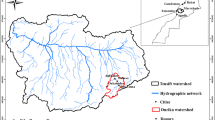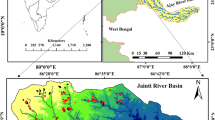Abstract
This work summarizes the results of a geomorphological and bivariate statistical approach to gully erosion susceptibility mapping in the Turbolo stream catchment (northern Calabria, Italy). An inventory map of gully erosion landforms of the area has been obtained by detailed field survey and air photograph interpretation. Lithology, land use, slope, aspect, plan curvature, stream power index, topographical wetness index and length-slope factor were assumed as gully erosion predisposing factors. In order to estimate and validate gully erosion susceptibility, the mapped gully areas were divided in two groups using a random partitions strategy. One group (training set) was used to prepare the susceptibility map, using a bivariate statistical analysis (Information Value method) in GIS environment, while the second group (validation set) to validate the susceptibility map, using the success and prediction rate curves. The validation results showed satisfactory agreement between the susceptibility map and the existing data on gully areas locations; therefore, over 88% of the gullies of the validation set are correctly classified falling in high and very high susceptibility areas. The susceptibility map, produced using a methodology that is easy to apply and to update, represents a useful tool for sustainable planning, conservation and protection of land from gully processes. Therefore, this methodology can be used to assess gully erosion susceptibility in other areas of Calabria, as well as in other regions, especially in the Mediterranean area, that have similar morphoclimatic features and sensitivity to concentrated erosion.





Similar content being viewed by others
References
Alexander DE (1980) Calanchi-accelerated erosion in Italy. Geography 65:95–100
Amodio-Morelli L, Bonardi G, Colonna V, Dietrich D, Giunta G, Ippolito F, Liguori V, Lorenzoni S, Paglionico A, Perrone V, Piccarreta G, Russo M, Scandone P, Zanettin Lorenzoni E, Zuppetta A (1976) L’arco Calabro- Peloritano nell’orogene appenninico-maghrebide. Memorie della Società Geologica Italiana 17:1–60
Anabalagan R (1992) Landslide hazard evaluation and zonation mapping in mountainous terrain. Eng Geol 32:269–277
ARSSA (2003) Carta dei suoli della regione Calabria—scala 1:250000. Monografia divulgativa. ARSSA-Agenzia Regionale per lo Sviluppo e per i Servizi in Agricoltura, Servizio Agropedologia. Rubbettino pp 387
ARSSA (2005) Carta del rischio di erosione attuale e potenziale della regione Calabria—scala 1:250000, Monografia divulgativa, ARSSA-Agenzia Regionale per lo Sviluppo e per i Servizi in Agricoltura, Servizio Agropedologia, Cerbone, Napoli 2005
Billi P, Dramis F (2003) Geomorphological investigation on gully erosion in the Rift Valley and the northern highlands of Ethiopia. Catena 50:353–368
Bull J, Kirkby MJ (2002) Channel heads and channel extension. In: Bull LJ, Kirkby MJ (eds) Dryland Rivers: hydrology and geomorphology of semi-arid channels. Wiley, Chichester, pp 263–298
Caloiero D, Mercuri T, Reali C (1990) Le precipitazioni in Calabria (1921–1980). Geodata 36 CNR IRPI, Cosenza
Carobene L, Mengani ME, Oliverio M (1989) Superfici terrazzate pleistoceniche nella media valle del fiume Crati (Calabria). Il Quaternario 2:15–39
Carrara A, Cardinali M, Detti R, Guzzetti F, Pasqui V, Reichenbach P (1991) GIS techniques and statistical models in evaluating landslide hazard. Earth Surf Proc Land 16:427–445
Carrara A, Cardinali M, Guzzetti F, Reichenbach P (1995) GIS technology in mapping landslide hazard. In: Carrara A, Guzzetti F (eds) Geographical information systems in assessing natural hazards. Kluwer, Dordrecht, pp 135–175
Çevik E, Topal T (2003) GIS-based landslide susceptibility mapping for a problematic segment of the natural gas pipeline, Hendek (Turkey). Environ Geol 44:949–962
Chung CF, Fabbri AG (2003) Validation of spatial prediction models for landslide hazard mapping. Nat Hazards 30:451–472
Colella A, De Boer PL, Nio SD (1987) Sedimentology of a marine intermontane Pleistocene Gilbert-type fan-delta complex in the Crati Basin, Calabria, southern Italy. Sedimentology 34:721–736. doi:10.1111/j.1365-3091.1987.tb00798.x
Collison AJC (2001) The cycle of instability: stress release and fissure flow as controls on gully head retreat. Hydrol Process 15:3–12
Conforti M (2008) Studio geomorfopedologico dei processi erosivi nel bacino del T. Turbolo (Calabria settentrionale) con il contributo della spettrometria della riflettenza. PhD thesis, University of Calabria, pp 310
Conoscenti C, Di Maggio C, Rotigliano E (2008) Soil erosion susceptibility assessment and validation using a geostatistical multivariate approach: a test in Southern Sicily. Nat Hazards 46:287–305
Dai FC, Lee CF, Li J, Xu ZW (2001) Assessment of landslide susceptibility on the natural terrain of Lantau Island, Hong Kong. Environ Geol 40:381–391
Dramis F, Gentili B (1977) Contributo allo studio delle acclività dei versanti nell’Appennino Umbro. Marchigiano. Stud Geol Camerti 3:153–164
Federici PR, Puccinelli A, Cantarelli E, Casarosa N, D’Amato Avanzi G, Falaschi F, Giannecchini R, Pochini A, Ribolini A, Bottai M, Salvati N, Testi C (2007) Multidisciplinary investigations in evaluating landslide susceptibility—an example in the Serchio River valley (Italy). Quat Int 171–172:52–63
Gattinoni P (2008) Parametrical landslide modeling for the hydrogeological susceptibility assessment: from the Crati Valley to the Cavallerizzo landslide (Southern Italy). Nat Hazards 50:161–178. doi:10.1007/s11069-008-9328-1
Guzzetti F, Carrara A, Cardinali M, Reichenbach P (1999) Landslide hazard evaluation: a review of current techniques and their application in a multi-scale study, Central Italy. Geomorphology 31:181–216
Iovine G, Petrucci O, Rizzo V, Tansi C (2006) The March 7th 2005 Cavallerizzo (Cerzeto) landslide in Calabria—Southern Italy. Engineering geology for tomorrow’s cities—the 10th IAEG congress, Nottingham (UK), The Geological Society of London, Paper number 785
Jenks GF (1989) Geographic logic in line generalization. Cartographica 26(1):27–42
Kakembo V, Xanga WW, Rowntree K (2009) Topographic thresholds in gully development on the hillslopes of communal areas in Ngqushwa Local Municipality, Eastern Cape, South Africa. Geomorphology 110:188–195
Köppen W (1936) Das geographische System der Klimate. In: Köppen W, Geiger R, Teil C (eds) Handbuch der Klimatologie. Band 5. Gebrüder Bornträger, Berlin, pp 1–46
Lanzafame G, Zuffa G (1976) Geologia e petrografia del foglio Bisignano (Bacino del Crati, Calabria). Geologica Romana 15:223–270
Lee S (2004) Soil erosion assessment and its verification using the Universal Soil Loss Equation and geographic information system: a case study at Boun, Korea. Environ Geol 45:457–465
Magliulo P, Di Lisio A, Russo F, Zelano A (2008) Geomorphology and landslide susceptibility assessment using GIS and bivariate statistics: a case study in southern Italy. Nat Hazards 47:411–435
Maharaj R (1993) Landslide processes and landslide susceptibility analysis from an upland watershed: a case study from St Andrew, Jamaica, West Indies. Eng Geol 34:53–79
Martínez-Casasnovas JA, Antón-Fernández C, Ramos MC (2003) Sediment production in large gullies of the Mediterranean area (NE Spain) from high-resolution digital elevation models and geographical information systems analysis. Earth Surf Process Landf 28:443–456. doi:10.1002/esp.451
Moore ID, Burch GJ (1986) Physical basis of the length-slope factor in the universal soil loss equation. Soil Sci Soc Am J 50:1294–1298
Moore ID, Grayson RB, Ladson AR (1991) Digital terrain modelling: a review of hydrological, geomorphological, and biological applications. Hydrol Process 5:3–30
Moretti S, Rodolfi G (2000) A typical “calanchi” landscape on the Eastern Apennine margin (Atri, Central Italy): geomorphological features and evolution. Catena 40:217–228
Morgan RPC (2005) Soil Erosion and Conservation, 3rd edn. Wiley, New York
Nagarajan R, Roy A, Vinod Kumar R, Mukherjee A, Khire MV (2000) Landslide hazard suspectibility mapping based on terrain and climatic factors for tropical monsoon regions. Bull Eng Geol Env 58:275–287
Ndomba Pm, Mtalo F, Killingtveit A (2009) Estimating gully erosion contribution to large catchment yield rate in Tanzania. Phys Chem Earth 34:741–748
Nefeslioglu HA, Duman TY, Durmaz S (2008) Landslide susceptibility mapping for a part of tectonic Kelkit Valley (Eastern Black Sea region of Turkey). Geomorphology 94:401–418
Poesen J, Vandaele K, Van Wesemael B (1998) Gully erosion: importance and model implications. In: Boardman J, Favis-Mortlock D (eds) Modelling soil erosion by water, vol I 55. NATO ASI Series, Springer, Berlin Heidelberg, pp 285–311
Poesen J, Vandekerckhove L, Nachtergaele J, Oostwoud Wijdenes D, Verstraeten G, Van Wesemael B (2002) Gully erosion in dryland environments. In: Bull LJ, Kirkby MJ (eds) Dryland Rivers: hydrology and geomorphology of semi-arid channels. Wiley, Chichester, pp 229–262
Pulice I, Scarciglia F, Leonardi L, Robustelli G, Conforti M, Cuscino M, Lupiano V, Critelli S (2009) Studio multidisciplinare di forme e processi denudazionali nell’area di Vrica (Calabria orientale). Bollettino della Società Geografica Italiana 87(I–II):399–414
Rautela P, Lakhera RC (2000) Landslide risk analysis between Giri and Ton Rivers in Himalaya (India). Int J Appl Earth Obs Geoinf 2:153–160
Remondo J, Gonzalez A, Teran J, Cendrero A, Fabbri A, Chung C (2003) Validation of landslide susceptibility maps; examples and applications from a case study in Northern Spain. Nat Hazards 30:437–449
Renard KG, Foster GR, Weesies GA, Mccool DK, Yoder DC (1997) Predicting soil erosion by water: a guide to conservation planning with the revised soil loss equation (RUSLE). US Dept. of Agriculture. Agric. Handbook No. 703, pp 404
Sorriso-Valvo M, Tansi C (1996) Relazioni tra frane, forme del rilievo e strutture tettoniche nella media Valle del Fiume Crati (Calabria). Geografia Fisica e Dinamica Quaternaria 19:107–117
Sorriso-Valvo M, Bryan RB, Yair A, Iovino F, Antronico L (1995) Impact of afforestation on hydrological response and sediment production in a small Calabrian catchment. Catena 25:89–104
Sùzen ML, Doyuran V (2003) A comparison of the GIS based landslide susceptibility assessment methods: multivariate versus bivariate. Environ Geol 45:665–679
Terranova O, Antronico L, Coscarelli R, Iaquinta P (2009) Soil erosion risk scenarios in the Mediterranean environment using RUSLE and GIS: an application model for Calabria (southern Italy). Geomorphology 112:228–245
Tortorici L, Monaco C, Tansi C, Cocina O (1995) Recent and active tectonics in the Calabrian Arc (south Italy). Tectonophysics 243:37–55
USDA (2006) Keys to soil taxonomy, USDA (United States Department of Agriculture), Soil Survey Staff, 10th edit. Natural Resources Conservation Service, Washington DC, pp 333
Valentin C, Poesen J, Li Y (2005) Gully erosion: impacts, factors and control. Catena 63:132–153. doi:10.1016/j.catena.2005.06.001
Van Westen CJ (1993) Application of geographic information systems to landslide hazard zonation. ITC publ. no. 15, Int. Ins. for Aerospace and Earth Res. Surv, Enschede, The Netherlands, p 245
Van Westen CJ (1997) Statistical landslide hazard analysis. ILWIS 2.1 for Windows application guide. ITC publication, Enschede, pp 73–84
Vandekerckhove L, Poesen J, Oostwoudwijdenes DJ, Gyssels G, Beuselinck L, De Luna E (2000) Characteristics and controlling factors of bank gullies in two semi.arid Mediterranean environments. Geomorphology 33:37–58
Vanwalleghem T, Poesen J, Nachtergaele J, Verstraeten G (2005) Characteristics, controlling factors and importance of deep gullies under cropland on loess.derived soils. Geomorphology 69:76–91
Wang HB, Sassa K (2005) Comparative evaluation of landslide susceptibility in Minamata area, Japan. Environ Geol 47:956–966
Wilson JP, Gallant JC (2000) Terrain analysis principles and applications. Wiley, Toronto Canada, p 479
Yalcin A (2008) GIS-based landslide susceptibility mapping using analytical hierarchy process and bivariate statistics in Ardesen (Turkey): comparison of results and confirmations. Catena 2:1–12
Yin KJ, Yan TZ (1988) Statistical prediction model for slope instability of metamorphosed rocks. In: Proceedings of the 5th international symposium on landslides, Lausanne, Switzerland, vol 2, pp 1269–1272
Zezere JL, Reis E, Garcia R, Oliveira S, Rodrigues ML, Vieira G, Ferreira AB (2004) Integration of spatial and temporal data for the definition of different landslide hazard scenarios in the area north of Lisbon (Portugal). Nat Haz Earth Sys Sci 4:133–146
Author information
Authors and Affiliations
Corresponding author
Rights and permissions
About this article
Cite this article
Conforti, M., Aucelli, P.P.C., Robustelli, G. et al. Geomorphology and GIS analysis for mapping gully erosion susceptibility in the Turbolo stream catchment (Northern Calabria, Italy). Nat Hazards 56, 881–898 (2011). https://doi.org/10.1007/s11069-010-9598-2
Received:
Accepted:
Published:
Issue Date:
DOI: https://doi.org/10.1007/s11069-010-9598-2




